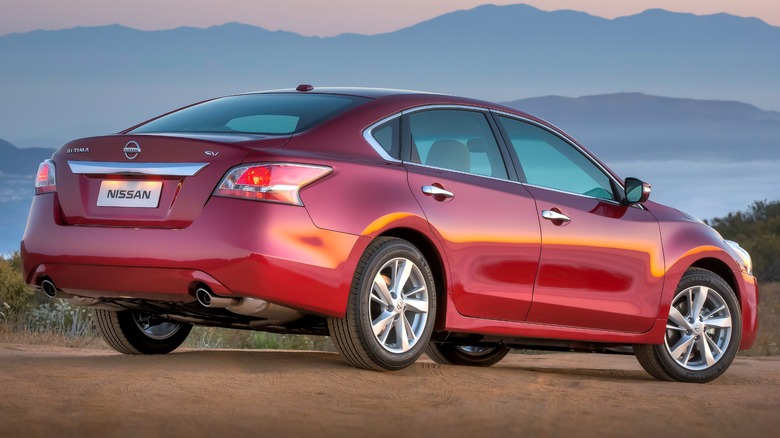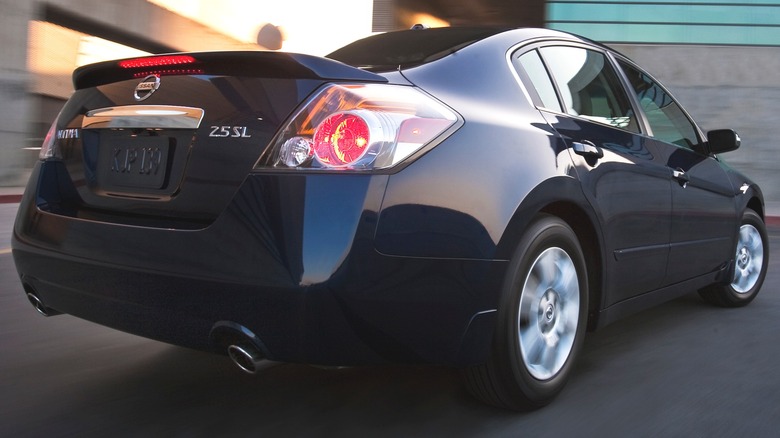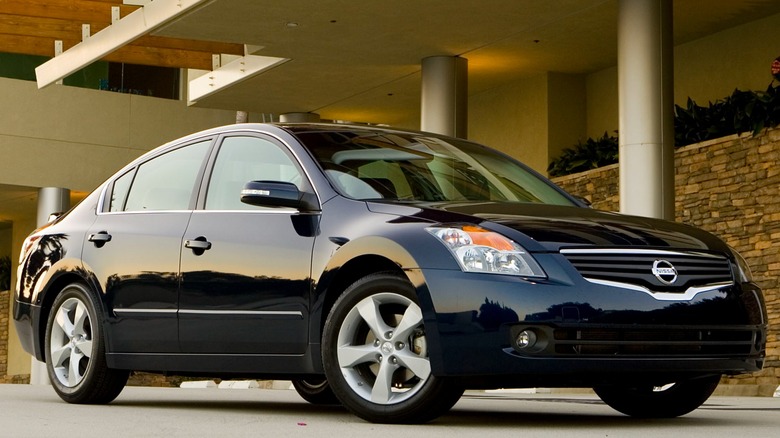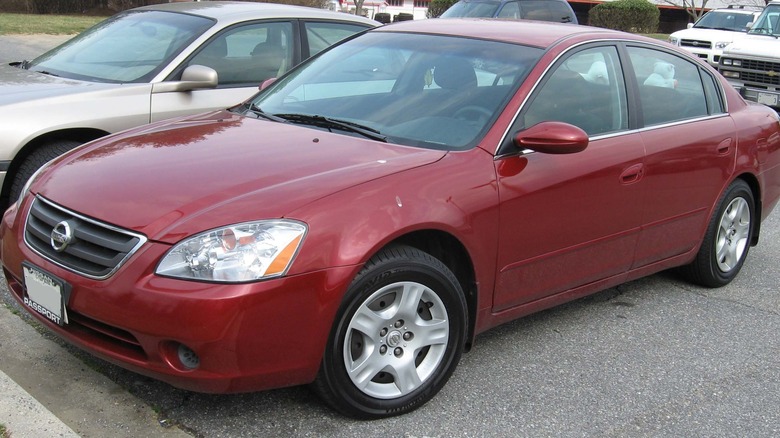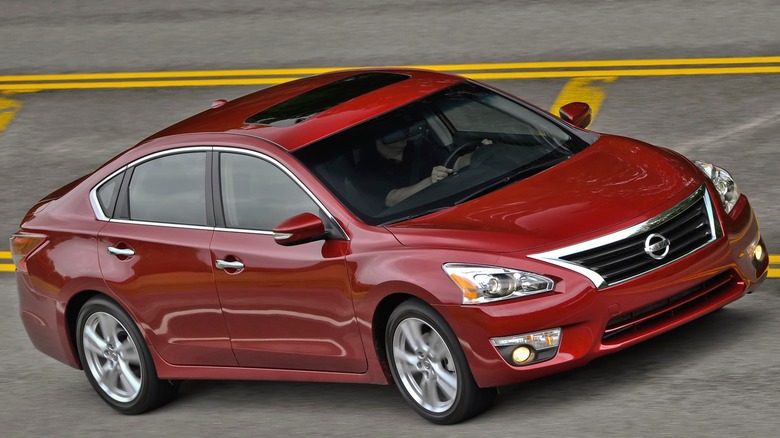The Best Years For Nissan Altima (And Some To Avoid)
In 1992, Nissan introduced the Altima, a practical sedan that was surprisingly fun to drive. In the compact-size commuter car market, this slightly edgier-looking and less expensive cousin to the Honda Accord and Toyota Camry has been a top-selling vehicle for Nissan over the years. Fans of the car praised the sedan for its reliability, roomy interior, fun handling, and in 2019 added AWD in order to help it compete with crossovers.
That said, alongside these rave reviews in Nissan chat rooms across the web are the complaints of anguished owners about issues with the continuous variable transmission (CVT) issues, assorted recalls, steering columns that lock up, and rear doors and hoods that unhelpfully pop open while driving. Are they talking about the same car? Yes, but not the same model year. If you're shopping for a Nissan Altima from the past two decades, it's important to know which year models are best to get, and which ones you'd be better off avoiding.
2011-2012 Nissan Altima
In 2010, the Altima went through a slight redesign that tweaked its nose and added standard stability control. What followed are arguably two of Altima's most solid model years — 2011 and 2012. In these two years, Nissan added three new colors (including Metallic Slate, Saharan Stone and Brilliant Silver), as well as new package options. However, perhaps because the sedan was relatively unchanged from 2010, Nissan had a chance to improve reliability, leading to fewer registered complaints. NHTSA gave the 2011 and 2012 overall safety ratings of four stars out of five. There was only one recall: for potentially under-torqued transverse link bolts, according to the NHTSA.
These models offered a 2.5-liter four-cylinder or 3.5-liter V6 engine, roomy interiors, and more technology and sportier styling than many others in its class. Nissan balanced the practical (large trunk and roomy interior) with driving fun — something the competition wasn't exactly known for. The 4-cylinder engine even boasted respectable gas mileage, with 26 mpg combined. Impressively, the 2012 Altima included standard safety features like anti-lock brakes, side-impact airbags for the front seats, side curtain airbags for front and back seats, and stability and traction control.
2007 Nissan Altima
The 2007 model year for the Altima was an attractively put-together car with a pleasing interior, but that's not all. According to Nissan, the 2007 was redesigned on its all-new "D" platform designed to increase body rigidity, which, along with the new suspension and standard front and rear stabilizer bars, improved the ride and the Altima's handling. Another ride-smoothing change for this fourth-generation sedan was the availability of Nissan's advanced Xtronic CVT (Continuously Variable Transmission), a transmission built to avoid shift shock because there are no physical, traditional gears.
Altima fans love the car for its class-leading technology without the giant sticker price. Of course, 2007 included plenty of tech for drivers, such as push start ignition, Bluetooth hands-free phone connection, a rear-view camera, and a navigation system. Still a front-wheel drive in this model year, the 2007 Altima provided comfortable, nimble driving — with only a few recalls and complaints that addressed suspension and air bag fixes.
2004 Nissan Altima
This model is another good choice for today's used Altima shoppers. It was a good model for shoppers in 2004, too, since it was Nissan's best-selling vehicle that year. It represented the third year of the Nissan Altima's third generation, meaning Nissan had the time to smooth out the rough edges after major developmental changes. According to the NHTSA, despite 5 recalls, the car had a low number of registered complaints. Again, Nissan went with structural improvements with this generation to add body stiffness for a better ride with less noise and vibration.
Without bumping up the sticker price very much from the previous model year, the Altima offered a lot in 2004; with a choice of 4-cylinder or V6 engines and a variety of option packages called Convenience, Sport, Leather, and even Leather Sport for upscale features. Some of the options highlights include a Bose audio system, auto-dimming rearview mirror, heated outside mirrors, and combinations with side air bags, ABS, and Traction Control.
[Featured image by IFCAR via Wikimedia Commons | Cropped and scaled | Public domain]
The Nissan Altima model years to avoid
For all the fans that the Nissan Altima may have gained over years of affordable driving fun packed into a sedan, there have been model years that owners regret purchasing. The 2009 Nissan Altima had 4 recalls and 1,536 registered complaints, according to the NHTSA. More than 800 complaints were related to steering, and more than 400 were referring to electrical system issues.
Not to paint too broad a stroke, but the fifth generation (2013-2019) had a number of problems across multiple model years, and might be best avoided when used car shopping. The NHTSA lists 12 recalls and 2,244 complaints for the 2013 model, focused largely on problems with airbags not deploying, the engine, the suspension, and hood latch corrosion that allowed the hood to pop open while driving.
The 2015 Nissan Altima in particular had a dangerous quirk that the NHTSA said could cause "the rear passenger door to unlatch and inadvertently open without warning when the window is lowered." Additionally, model years 2013–2016 of the Altima were involved in a class action lawsuit related to its CVT. All this is to say, be sure to research any car before you buy to make sure it was a good year.
